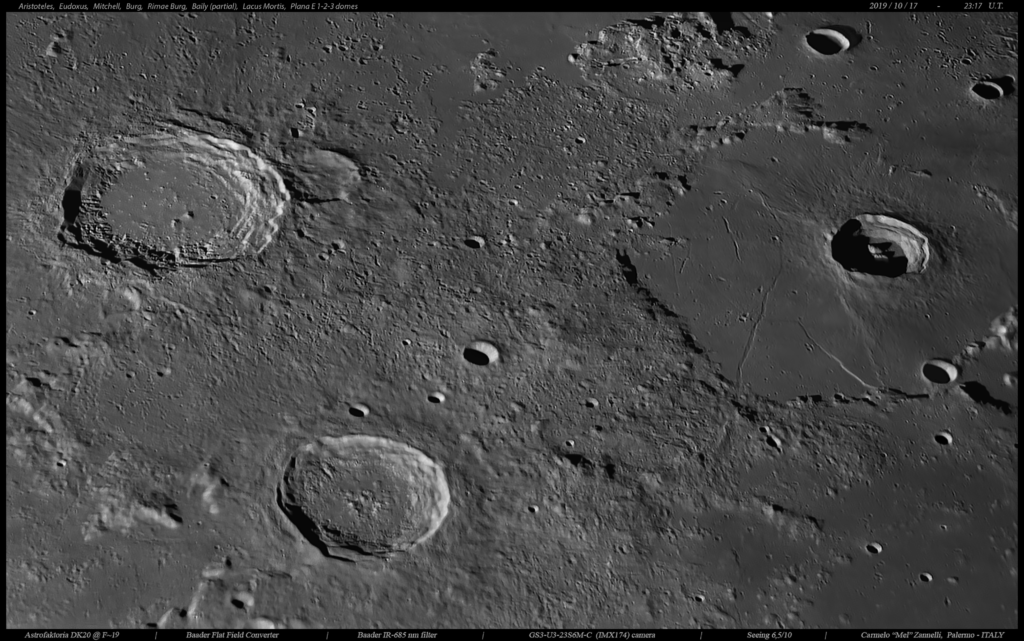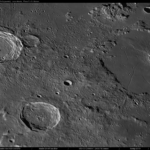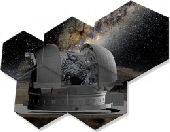Italiano:
Questa immagine lunare ritrae un terzetto di crateri molto evidenti, visibili un giorno prima del primo quarto lunare o quattro/cinque giorni dopo la Luna piena. Si tratta dei crateri Aristoteles (qui visibile in alto a sinistra) ed Eudoxus (in basso vicino il centro) di cui ho già ampiamente parlato in altra immagine dedicata, al link http://www.carmelozannelli.com/site/?p=2206 e di un altro particolare cratere da impatto, inserito in una ampia zona di distesa lavica: si tratta del cratere “Bürg” e del lago di lava chiamato “Lacus Mortis“.
Il cratere “Bürg” (visibile vicino il centro a destra) è un importante cratere da impatto lunare, con un diametro di circa 40 Km ed una profondità di circa 1,8 km, situato nella parte nord-est della Luna ed inserito, come anzidetto, all’interno della antica formazione inondata di lava, denominata “Lacus Mortis”.
Il bordo di Bürg è quasi circolare e relativamente poco eroso da altri cambiamenti del tempo. L’interno è a forma tipicamente concava e al centro si trova un grande picco centrale di forma irregolare, con due vette più alte che si stagliano dal fondo per circa 1800 metri. Esso ha un sistema a raggi ed è, di conseguenza, catalogato come parte del “sistema copernicano” di crateri lunari.
A ovest di esso c’è un sistema a rille (fratture) designato “Rimae Bürg”, che si estende per una lunghezza di circa 100 chilometri all’interno del Lacus Mortis. Si suppone che queste “rimae” si siano formate da flussi di “lava tube” o tubi di lava.
Il “Lacus Mortis”, dal latino “Lago della morte”, è una pianura di flussi di lava basaltica del diametro di circa 151 km, situato nella parte nord-orientale della Luna dove è inserito il predetto cratere Burg. Si trova appena a sud del Mare Frigoris, essendo separato da esso da un braccio sottile di terreno accidentato.
Grazie per l’attenzione.
Dettagli tecnici:
Telescopio Astrofaktoria DK20 @ ~ F/19 – Baader FFC Multiplier – Baader IR 685nm filter – GS3-U323S6M-C camera – Seeing 6,5/10 in IR band – sito: Palermo @ my personal Observatory
English:
This lunar image shows a trio of beautiful craters, visible one day before the first lunar quarter or four/five days after the full moon. These are “Aristoteles” (visible here at the top left) and Eudoxus (at the bottom near the center) lunar craters, of which I have already shown extensively in another dedicated image, at the link http://www.carmelozannelli.com/site/?p= 2206 and another particular impact crater, inserted in a large area of lava flow: these are the “Bürg” crater and “Lacus Mortis” lava floor.
The “Bürg” crater (visible near the center on the right) is an important lunar impact crater, with a diameter of about 40 km and a depth of about 1.8 km, located in the north-east part of the moon and inserted, as mentioned above, within the ancient lava-flooded formation, called “Lacus Mortis”.
The edge of Bürg is almost circular and relatively eroded by the time. The inside is typically concave in shape and in the center there is a large central peak with an irregular shape, with two higher peaks that stand out from the bottom for about 1800 meters.
To the west of it there is a rille system (rimae) designated “Rimae Bürg”, which extends for a length of about 100 kilometers within the Lacus Mortis. These “rimae” are supposed to have formed from “lava tube” streams.
The “Lacus Mortis”, is a plain of basaltic lava flows with a diameter of about 151 km, located in the north-eastern part of the Moon, where the aforementioned Burg crater is inserted. It is located just south of the Mare Frigoris, being separated from it by a thin arm of rough terrain.
Thanks for your attention!
Technical details:
Astrofaktoria DK20 telescope @ ~ F/19 – Baader FFC Multiplier – Baader IR 685nm filter – GS3- U323S6M-C camera – Seeing 6.5/10 in IR band – site: Palermo @ my personal Observatory


